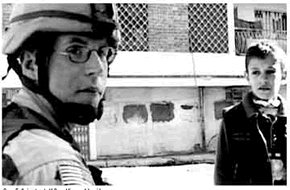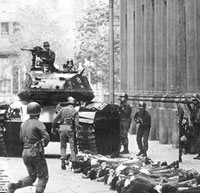 In 2007, the world spent approximately $1.1 trillion on military expenditure - for making weapons and training people to kill, rather than for creating a better and sustainable world for all. An enormous amount of skills, resources, and energies go towards developing better killing machines and weapons and supporting the military-industrial complex, instead of going towards the betterment of society and the planet.
In 2007, the world spent approximately $1.1 trillion on military expenditure - for making weapons and training people to kill, rather than for creating a better and sustainable world for all. An enormous amount of skills, resources, and energies go towards developing better killing machines and weapons and supporting the military-industrial complex, instead of going towards the betterment of society and the planet.
The US spends over half of this $1.1 trillion dollars on defense (approx. $623 billion). And the US is going to spend an additional $200 billion or so for the war in Iraq. Imagine how much better the world would be, had that same $200 billion been used for social and humanitarian activities (like poverty reduction, food, housing, education and sanitation) in Iraq and the Middle East.
As of December 2007, at least 18 significant ongoing armed conflicts were raging around the world (the UN defines "major wars" as conflicts that induce 1,000 or more deaths). Armed conflict costs more than human lives. The 1999 Report of the UN Secretary-General says that the economic costs of seven major wars (not including Kosovo) in the 1990s to the international community is at least $199 billion. This does not even include the economic costs of war to the countries in conflict.
Other important areas affected by armed conflict are:
Eco-terrorism: destruction of the environment as a weapon.
A well-known example is the U.S. military's use of Agent Orange to destroy food sources and foliage during the Vietnam Var. More recently, the destruction of Kuwaiti oil wells by retreating Iraqi military forces during the 1991 Persian Gulf War, released tons of gaseous pollutants like carbon dioxide and sulfur dioxide into the atmosphere, causing black, greasy rains to fall in Saudi Arabia and Iran and black snow in Kashmir (over 1,500 miles away). Environmental destruction as collateral damage
The explosion of a heavy bomb creates temperatures of approximately 3,000 degrees Celsius. This annihilates all flora and fauna and completely destroys the lower layers of soil, which can take anywhere from 1,500 to 7,400 years to regenerate.
Long after conflicts have ended, land mines can continue to render conflict zones uninhabitable. Once laid, land mines can stay active for up to 50 years. These weapons cost little to manufacture, but can cost up to $1,000 to remove. Land-mines can be laid by mine-laying vehicles or ejected by cluster bombs at rates of over 1,000 per minute, but it requires a skilled expert an entire day just to clear 20-50 square meters of contaminated land by hand.
Over 20,000 sites on more than 1,700 U.S. military facilities are contaminated with conventional toxic wastes.
Depleted uranium (DU) - weapons are made from nuclear waste products.
DU is extremely dense, sharpens upon impact, and self-ignites. DU weapons are used to penetrate and detonate heavily armored combustible vehicles like tanks. On impact, DU produces a dust cloud that is chemically toxic, radioactive and light enough to spread quickly in the wind. These airborne particles are small enough to be inhaled, thus causing birth deformities, cancer, degenerative diseases, paralysis, or death depending on the level of exposure.
DU is so fine that it seeps deep into the soil, penetrating the water aquifers and contaminates any and all crops grown in the area where DU weapons were exploded. Any animal grazing in those areas ingests the contaminated grasses and any human eating that animal ingests the contaminated animal. Mothers who have breathed the dust or eaten contaminated crops or animals produce contaminated milk when they breastfeed their infants.
DU was first extensively used by US forces in the 1991 Persian Gulf War (the first break with the post-Hiroshima convention against use of nuclear arms), then again by NATO in 1994-95 in Bosnia and Herzegovina and 1999 in the Kosovo conflict. It is currently used by US forces in Afghanistan and Iraq.
DU cannot be cleaned up and there is no known medical remedy. The environmental consequences of DU weapons residue will be felt for thousands of years as its decay products continually transform into even more hazardous radioactive substances. And, as one nuclear scientist wrote, "Radiation has no borders, respects no races or socio-economic classes…it’s going to get all of us”.
Social Casualties
- As of October 2006, forty countries (out of 195) face food shortages. One of the predominant causes of food shortages is civil strife.
- Hunger As A Weapon - Food stocks, means of food production, or food producers themselves are seized or destroyed. Food relief is diverted from intended beneficiaries to the military and their supporters.
- Hunger As Collateral Damage - Conflict creates poverty, which results in hunger. Markets and livelihoods are disrupted, leaving households without sufficient resources to get food.
- Children As Victims - Recently, the proportion of war victims who are civilians has jumped from 5 per cent to over 90 per cent. At least half of these war victims are children. During 1986-96, around 2 million children were killed in armed conflict. Three times as many were seriously injured or permanently disabled. Assault rifles are cheap and widely available, thanks to the international arms trade. In Uganda, an AK-47 can be purchased for the cost of a chicken. In some countries, government or rebel armies have recruited (often forcibly) tens of thousands of children to use these lightweight weapons. Most are adolescent boys, but some recruits are 10 years or younger.
- Physical Security - The 2006 UNHCR Statistical Yearbook estimates that there are 9.9 million refugees, 744,000 asylum-seekers and 12.8 million internationally displaced persons protected/assisted by UNHCR.
Military Spending
- World military expenditure estimated to be 1.2 trillion dollars in the year 2006.
- The US will spend $598 billion on military, but only $58.6 billion on education and $52.3 billion on health.
- The US will spend 48.6% of the world’s total military expenditures. This is almost as much as the rest of the world.
- There are still around 30,000 nuclear weapons in the world. A few hundred could destroy most of the world.
Source: http://www.worldcentric.org/conscious-living/militarism-and-conflicts
##
Revised 04/17/2016


 Old soldiers in the Civil War coined a phrase for green troops who survived their first taste of battle: "He has seen the elephant." This Army lieutenant sums up the combat experience better than many a grizzled veteran:
Old soldiers in the Civil War coined a phrase for green troops who survived their first taste of battle: "He has seen the elephant." This Army lieutenant sums up the combat experience better than many a grizzled veteran: Militarism is a value system that stresses the superiority of some people over others. Under militarism, the people deemed inferior are dehumanized as enemies who must be overpowered by any means necessary. Those who deem themselves superior are permitted to take whatever they want from others — land, freedom, natural resources, cultures, lives — by force.
Militarism is a value system that stresses the superiority of some people over others. Under militarism, the people deemed inferior are dehumanized as enemies who must be overpowered by any means necessary. Those who deem themselves superior are permitted to take whatever they want from others — land, freedom, natural resources, cultures, lives — by force.




